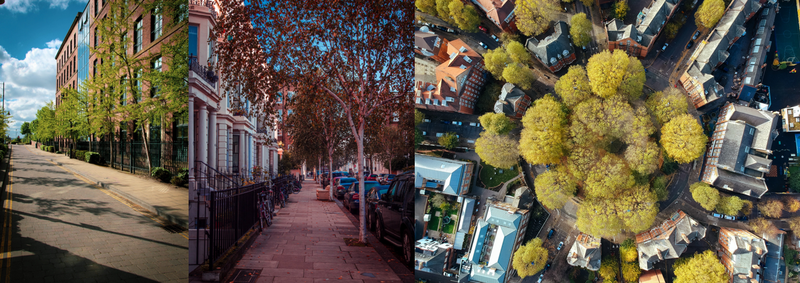Summary
The aim of this project was to provide a statistically robust contemporary perspective on individuals’ attitudes to trees in the urban landscape.
The research investigated individual and community level understanding of and support for, planting, management and maintenance of urban trees. It also compared the value of urban trees with other urban habitats, including managing or removing trees for other biodiversity or societal benefits. The evidence collected is designed to help inform local and national government, managers of infrastructure, and environmental organisations and professionals involved in the expansion, management and maintenance of urban tree cover.
Research Objectives
- Produce a synthesis of existing research and evidence to create a state-of-the-art overview of public perceptions of urban trees.
- Organise meetings with key stakeholders to understand their evidence needs and use these to shape research questions, analysis approach, reporting, and onward communication.
- Generate in-depth qualitative data from focus groups that reveals key issues and topics around urban trees.
- Use a national survey to generate statistically robust evidence about individual’s views of urban trees, disaggregated by country (England, Scotland, Wales) spatial and socio-demographic characteristics.

Results
Respondents across all three countries identified a wide range of benefits from urban trees, mental health benefits and urban biodiversity were emphasised.
The majority of survey respondents thought that tree cover in their town or city was about right, but around a third thought there could be more tree cover, or they would like to see bigger trees.
Urban trees in all settings were appreciated, but those in urban parks and similar settings were seen as the most beneficial.
Support for tree planting in urban areas was generally high, with a consensus that government money and finance raised by polluting businesses and activities should cover costs of planting and managing trees.
In some cases respondents noted the need for equity in planning tree cover into areas that currently have fewer street trees, woodlands and greenspaces with trees.
There was recognition that urban trees could have disbenefits, e.g. alongside roads and railways lines, but good quality management of trees was seen to mitigate against these.
About 50% of people felt more connected to urban trees since the COVID lockdowns, and many felt attached to trees through folk stories and sayings and personal childhood memories of interaction with particular trees.
There were differences by age, gender and ethnicity, and by region or country, for some of the questions asked, but the statistical significance of these was very small in most cases.
Outputs
Report summarising key findings from the Focus Group discussions (see ‘Downloads’ below)
Article in ICF magazine Trees, Winter 2021 edition
Additional outputs in the form of a journal paper/s are planned for 2022
Downloads
Funding & Partners
-
 Network Rail
Network Rail -
 The Woodland Trust
The Woodland Trust -
 Forestry Commission
Forestry Commission -
 The Mersey Community Forest
The Mersey Community Forest
